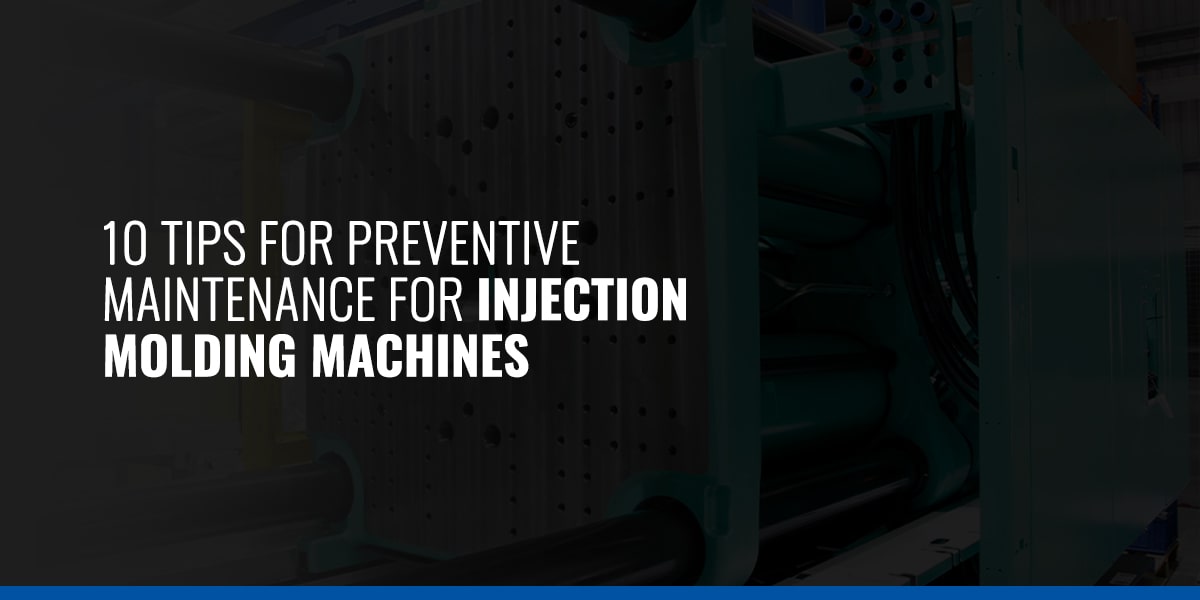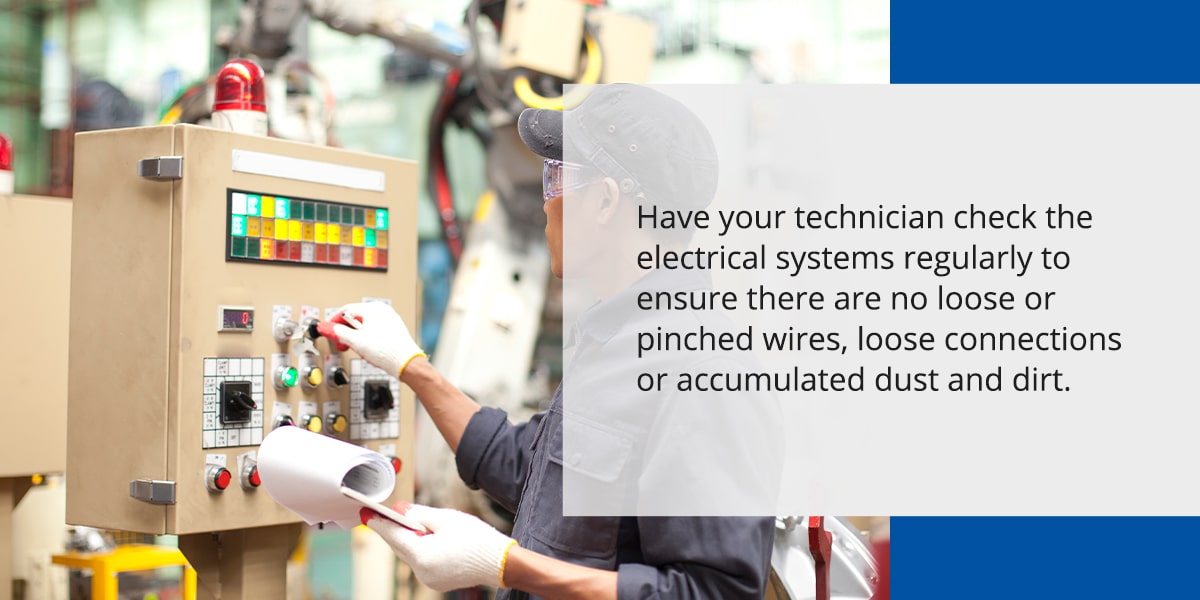Industrial injection molding machines produce high-quality plastic products that we use in everyday life. These machines represent big investments in your production facility, and you want to do what you can to maintain them properly.
Taking care of your equipment helps to extend the life of your machinery and significantly reduces unplanned stoppages and rejected products. You can ensure your injection molding machine is operating properly and producing products without error through careful preventive maintenance.
At Plasti-Co® and AIC Equipment, we know what it takes to keep your injection molding machines running smoothly. We’ve compiled these ten tips to help you create a maintenance checklist for your injection molding machines.
1. Keep Molds and Components Clean and Dry
Your mold cavities and components are critical to producing quality products, so you should take special care to plan injection mold maintenance and ensure they’re in the best shape possible. After each production cycle, thoroughly clean each mold with a gentle solvent and use compressed air to remove any debris.
Be sure to remove any moisture from your molds before you store them — moisture left on metal molds could cause rust, damage the molds and produce poor-quality products.
2. Perform Safety Checks
Injection molding machines feature safety limit switches that can become damaged over time as they get bumped, which can cause malfunctions. Include safety checks as part of your regular injection molding machine maintenance routine to keep your operators safe and keep your machines running on schedule.
Also, be sure to check the bolts holding the limit switch in place and that the trip arms are adjusted for your usage.
Call 810-207-6454 For Your Maintenance Needs
3. Ensure Your Machine Is Level and Parallel
During normal operation, your injection molding machine jostles and vibrates. If the machine is not level, the movement could result in uneven wear to crucial parts like rods and bushings. Machines not sitting level may also experience uneven grease flow, which could cause extra friction and more wear.
To combat this wear, you’ll want to keep your machine level and parallel to the moving platen and stationary platen. We recommend leveling your machine as part of your monthly preventive maintenance.
4. Check Your Oil
If you have a hydraulic molding machine, you rely on high-quality oil to keep it running. You should monitor your oil to watch for leaks, maintain levels and keep clean oil flowing through your hydraulic mechanisms.
Oil checks should be part of your regular preventive maintenance schedule, with oil filter changes at the start of every quarter. When you check your oil, you should also check for and replace any worn seals and tighten any loose joints.
5. Check Electrical Components and Wiring
Hybrid or fully electric injection molding machines rely on strong electrical connections for optimal operation. To maintain these machines, you’ll need a technician who understands the electrical systems. Have your technician check the electrical systems regularly to ensure there are no loose or pinched wires, loose connections or accumulated dust and dirt.
6. Change Your Filters and Clean Tank Breathers
Maintaining proper airflow allows your mold machine to operate smoothly. A dirty air filter will restrict the air entering and exiting your cabinet, while a blocked tank breather may cause the tank to expand and contract as oil flows to and from the tank. Both circumstances could result in strain on the welds of your reservoir or reduced performance.
Replace your cabinet air filter as part of your scheduled mold machine maintenance and keep your tank breather clean and free of debris by regularly cleaning the top and outside of your machine.
7. Clean Your Machine
Over time, a fine layer of dust and grime may build up on the outside of your injection molding machine. This buildup could result in electrical problems or clogged filters that limit your machine’s efficacy. This is especially problematic for electric injection molding machines that rely on strong electrical connections to operate.
You should clean all over the outside of your machine at least annually to remove this buildup and protect your machine from potential hazards.
8. Make Sure Moving Parts Are Lubricated
Your injection molding machine has several moving parts that rely on proper lubrication to move smoothly without significant friction or wear. To maintain your machine, make sure there is a film of grease on all of these important parts, like the rods and skates.
If parts that should be greased are not, you’ll need to check to make sure that grease is flowing properly through your lines and reaching these lubrication points. Check for blockages and air bubbles in your lines that may be limiting your grease flow.
9. Check Your Heater Bands
Malfunctioning heater bands can cause defects in your final products. Inspect your heater bands regularly to ensure they’re reaching the correct temperature in each zone and making proper contact with the barrel.
If it seems like your bands are not maintaining the correct temperature, or the temperature varies along in different zones, consult a qualified electrician who can test the zones to identify where you have a malfunction.
Replace any heater bands that are fluctuating in temperature or not working properly. While you have your machine down replacing one band, consider replacing the whole set. This step could help you avoid future downtime to change other bands as they fail.
10. Invest in Predictive Maintenance Upgrades
Upgrading your injection molding machine to include predictive maintenance monitoring systems is a great way to stay on top of your preventive maintenance schedule and keep an eye on your machine’s smaller, more hidden components like tiny screws.
These systems include sensors that note changes to your machine’s parts and monitor wear to notify you when a part is near a failure point and needs to be replaced. When you’re actively monitoring the status of these parts, you can be sure to replace them before they fail, preventing unplanned downtime.
You can also plan to replace or repair aging parts at the same time, allowing you to optimize and minimize your scheduled downtime for mold machine maintenance.
Team Up With AIC Equipment and Plasti-Co® to Maintain Your Molding Machines
Since 1974, Plasti-Co® and AIC Equipment have been your partner in installing and maintaining the machinery you need to create top-quality products. We work with you to help find manufacturing solutions, including large capital equipment, auxiliary equipment and aftermarket parts like small screws and barrels that we manufacture to meet your exact needs.
We take special care to ensure our products and services are a perfect match for your application, building systems and equipment designed specifically for you. Contact our knowledgeable service team for help establishing a preventive maintenance plan for your molding machines, or to get the parts you need to keep your injection mold machine running smoothly.
To get in touch with our team, fill out our online contact form or give us a call at 800-521-0612.



